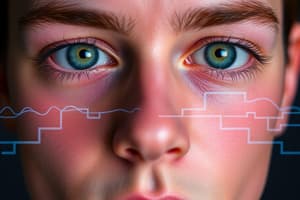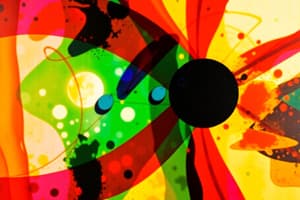Podcast
Questions and Answers
What is described as the process of detecting and transmitting raw sensory information to the brain?
What is described as the process of detecting and transmitting raw sensory information to the brain?
- Sensation (correct)
- Psychophysics
- Transduction
- Perception
What is the term for the minimum stimulation needed to detect a particular stimulus 50% of the time?
What is the term for the minimum stimulation needed to detect a particular stimulus 50% of the time?
- Weber's Law
- Absolute Threshold (correct)
- Transduction
- Difference Threshold
Which of the following describes Weber's Law?
Which of the following describes Weber's Law?
- The JND is a variable that changes with stimulus intensity. (correct)
- The JND is irrelevant in sensory perception.
- The JND is always the same for different stimuli.
- The JND decreases as the original stimulus increases.
What does transduction involve?
What does transduction involve?
What does the sensation of pressure fall under in psychophysics?
What does the sensation of pressure fall under in psychophysics?
Which sense organ is primarily involved in detecting smell?
Which sense organ is primarily involved in detecting smell?
What is the experience derived from combining sensory input into meaningful patterns preferably called?
What is the experience derived from combining sensory input into meaningful patterns preferably called?
To what does the term 'difference threshold' refer?
To what does the term 'difference threshold' refer?
Which of the following best exemplifies how perceptions are formed?
Which of the following best exemplifies how perceptions are formed?
Which element is NOT considered a sense organ?
Which element is NOT considered a sense organ?
What does Signal Detection Theory primarily focus on?
What does Signal Detection Theory primarily focus on?
Which sensory system is responsible for balance and body position relative to gravity?
Which sensory system is responsible for balance and body position relative to gravity?
What is the role of amplitude in sound waves?
What is the role of amplitude in sound waves?
Which cue helps in depth perception by taking advantage of the differing images received by each eye?
Which cue helps in depth perception by taking advantage of the differing images received by each eye?
What does the term 'inattentional blindness' signify?
What does the term 'inattentional blindness' signify?
Which of the following best describes perceptual constancies?
Which of the following best describes perceptual constancies?
What occurs as a result of the Sensory Conflict Theory?
What occurs as a result of the Sensory Conflict Theory?
Which processing type starts with raw data and works toward higher-level cognitive understanding?
Which processing type starts with raw data and works toward higher-level cognitive understanding?
Which of the following is NOT one of the physical properties of sound waves?
Which of the following is NOT one of the physical properties of sound waves?
Flashcards
Sensation
Sensation
The process of detecting, converting, and transmitting raw sensory information from the sense receptors to the brain.
Perception
Perception
The process of the brain assembling and combining raw sensory input into meaningful patterns.
Psychophysics
Psychophysics
The study of the relationship between physical stimuli and the corresponding sensations they evoke.
Absolute Threshold
Absolute Threshold
Signup and view all the flashcards
Just Noticeable Difference (JND)
Just Noticeable Difference (JND)
Signup and view all the flashcards
Weber's Law
Weber's Law
Signup and view all the flashcards
Transduction
Transduction
Signup and view all the flashcards
Sensory Receptors
Sensory Receptors
Signup and view all the flashcards
Sense Organs
Sense Organs
Signup and view all the flashcards
Perceptions
Perceptions
Signup and view all the flashcards
Signal Detection Theory
Signal Detection Theory
Signup and view all the flashcards
Amplitude (Sound)
Amplitude (Sound)
Signup and view all the flashcards
Frequency (Sound)
Frequency (Sound)
Signup and view all the flashcards
Selective Attention
Selective Attention
Signup and view all the flashcards
Divided Attention
Divided Attention
Signup and view all the flashcards
Inattentional Blindness
Inattentional Blindness
Signup and view all the flashcards
Perceptual Constancy
Perceptual Constancy
Signup and view all the flashcards
Bottom-Up Processing
Bottom-Up Processing
Signup and view all the flashcards
Top-Down Processing
Top-Down Processing
Signup and view all the flashcards
Study Notes
Sensation and Perception
- Knowledge originates from perception
- Basic Senses: Vision, Hearing, Smell, Taste, Touch
- Sensation involves detecting stimuli, converting them to electrical signals, and transmitting them to the brain.
- Sense organs include eyes, ears, nose, tongue, skin, and internal organs.
- Perception is the brain's interpretation of sensory input.
Psychophysics
- Studies the relationship between physical stimuli and sensations.
- Examples of physical stimuli and how they are measured:
- Light: brightness, color
- Sound: volume, pitch
- Pressure: weight
- Taste: sweetness, saltiness etc.
- Transduction: converting physical energy to neural signals. Sensory receptors convert various energy forms (sound, light, pressure, chemicals) into nerve impulses.
Sensation Thresholds
- Absolute Threshold: minimum stimulus needed for detection 50% of the time.
- Just Noticeable Difference (JND) the minimum difference between two stimuli that can be detected 50% of the time.
Weber's Law
- The JND is a constant proportion, not a constant amount, of the original stimulus intensity.
Signal Detection Theory
- Predicts how and when we detect a signal amidst noise (background stimulation).
- No single absolute threshold; detection changes depending on factors.
Somesthetic Senses
- Vestibular: balance and position in space, affected by the semicircular canals (fluid filled canals in the inner ear).
- Kinesthetic: body position and movement.
- Touch: pressure, warmth, cold, pain.
Body Position and Movement
- Kinesthesis: senses position and movement of body parts.
- Vestibular sense: body movement and position relative to gravity, critical for balance.
Vestibular System and Motion Sickness
- Motion sickness occurs when vestibular system sensations conflict with visual and body sensations. This is called sensory conflict.
Auditory Sensation
- Transduction of air pressure vibrations into neural impulses.
- Sound waves comprise different frequencies and amplitudes.
- Amplitude: perceived as loudness
- Frequency: perceived as pitch
- Sound localization: the brain uses differences in intensity and arrival time of sound waves from each ear to pinpoint source.
Factors Influencing Perception
- Attention
- Organization
- Expectations
- Motivation
Perceptual Attention
- Selective attention: focusing on one stimulus, like the cocktail party effect.
- Divided attention: splitting focus between multiple tasks.
- Inattentional blindness: inability to perceive stimuli based on attention limits. Change blindness is a type of inattentional blindness.
Perceptual Constancies
- Ability to perceive stimuli consistently despite changes in sensory input.
- Color constancy: perceived color remains the same even with varying light.
- Size constancy: perceived size remains the same even at different distances.
- Shape constancy: perceived shape remains the same despite changes in viewing angle.
Depth Perception
- Ability to judge distance and perceive the world in three dimensions.
- Visual Cliff experiments: studied depth perception in infants.
Monocular Depth Cues
- Distance cues based on input from one eye.
- Accomodation: lens adjustment for focusing on different distances.
- Pictorial depth cues: provide info about space, depth, and distance.
- Linear perspective: parallel lines converging.
- Relative size: closer objects appear larger.
- Relative height: objects higher in frame seem farther.
- Light and shadow: simulate light sources.
- Interposition: closer objects overlap further objects.
- Texture gradients.
Binocular Depth Cues
- Distance cues based on input from both eyes.
- Convergence: eyes turning inward for close objects.
- Retinal disparity: different images from each eye creates depth perception.
Perceptual Expectations (Perceptual Set)
- Biased perception based on past experiences and expectations.
Top-Down vs. Bottom-Up Processing
- Top-down: perception guided by expectations and knowledge.
- Bottom-up: perception guided by stimulus features.
- Conceptually Driven: Whole to parts
- Data Driven: Parts to Whole
Parallel Processing
- Simultaneous processing of different aspects of a stimulus.
Perceptual Adaptation
- Adjustment to altered sensory input.
Studying That Suits You
Use AI to generate personalized quizzes and flashcards to suit your learning preferences.
Description
Explore the fascinating world of sensation and perception in this quiz based on Chapter 2 of Psychology. Dive into the basic senses, psychophysics, and learn about sensation thresholds. Test your understanding of how we detect and interpret stimuli from our environment.



